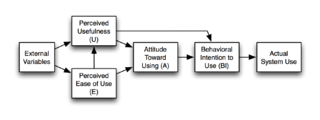
Assistive technology (AT) is a term for assistive, adaptive, and rehabilitative devices for people with disabilities and the elderly. Disabled people often have difficulty performing activities of daily living (ADLs) independently, or even with assistance. ADLs are self-care activities that include toileting, mobility (ambulation), eating, bathing, dressing, grooming, and personal device care. Assistive technology can ameliorate the effects of disabilities that limit the ability to perform ADLs. Assistive technology promotes greater independence by enabling people to perform tasks they were formerly unable to accomplish, or had great difficulty accomplishing, by providing enhancements to, or changing methods of interacting with, the technology needed to accomplish such tasks. For example, wheelchairs provide independent mobility for those who cannot walk, while assistive eating devices can enable people who cannot feed themselves to do so. Due to assistive technology, disabled people have an opportunity of a more positive and easygoing lifestyle, with an increase in "social participation", "security and control", and a greater chance to "reduce institutional costs without significantly increasing household expenses." In schools, assistive technology can be critical in allowing students with disabilities to access the general education curriculum. Students who experience challenges writing or keyboarding, for example, can use voice recognition software instead. Assistive technologies assist people who are recovering from strokes and people who have sustained injuries that affect their daily tasks.
Occupational therapists (OTs) are health care professionals specializing in occupational therapy and occupational science. OTs and occupational therapy assistants (OTAs) use scientific bases and a holistic perspective to promote a person's ability to fulfill their daily routines and roles. OTs have training in the physical, psychological, and social aspects of human functioning deriving from an education grounded in anatomical and physiological concepts, and psychological perspectives. They enable individuals across the lifespan by optimizing their abilities to perform activities that are meaningful to them ("occupations"). Human occupations include activities of daily living, work/vocation, play, education, leisure, rest and sleep, and social participation.

Accessibility is the design of products, devices, services, vehicles, or environments so as to be usable by people with disabilities. The concept of accessible design and practice of accessible development ensures both "direct access" and "indirect access" meaning compatibility with a person's assistive technology.

The technology acceptance model (TAM) is an information systems theory that models how users come to accept and use a technology.
Rehabilitation of sensory and cognitive function typically involves methods for retraining neural pathways or training new neural pathways to regain or improve neurocognitive functioning that have been diminished by disease or trauma. The main objective outcome for rehabilitation is to assist in regaining physical abilities and improving performance. Three common neuropsychological problems treatable with rehabilitation are attention deficit/hyperactivity disorder (ADHD), concussion, and spinal cord injury. Rehabilitation research and practices are a fertile area for clinical neuropsychologists, rehabilitation psychologists, and others.

Occupational therapy (OT) is a healthcare profession that involves the use of assessment and intervention to develop, recover, or maintain the meaningful activities, or occupations, of individuals, groups, or communities. The field of OT consists of health care practitioners trained and educated to improve mental and physical performance. Occupational therapists specialize in teaching, educating, and supporting participation in any activity that occupies an individual's time. It is an independent health profession sometimes categorized as an allied health profession and consists of occupational therapists (OTs) and occupational therapy assistants (OTAs). While OTs and OTAs have different roles, they both work with people who want to improve their mental and or physical health, disabilities, injuries, or impairments.
Service and supports for people with disabilities are those government or other institutional services and supports specifically provided to enable people who have disabilities to participate in society and community life. Some such services and supports are mandated or required by law, some are assisted by technologies that have made it easier to provide the service or support while others are commercially available not only to persons with disabilities, but to everyone who might make use of them.
Related services is defined by the United States Individuals with Disabilities Education Act ("IDEA") 1997 as,
Psychiatric rehabilitation, also known as psychosocial rehabilitation, and sometimes simplified to psych rehab by providers, is the process of restoration of community functioning and well-being of an individual diagnosed in mental health or emotional disorder and who may be considered to have a psychiatric disability.
Assistive technology service providers help individuals with disabilities acquire and use appropriate Assistive Technology (AT) to help them participate in activities of daily living, employment and education.
Supported employment refers to service provisions wherein people with disabilities, including intellectual disabilities, mental health, and traumatic brain injury, among others, are assisted with obtaining and maintaining employment. Supported employment is considered to be one form of employment in which wages are expected, together with benefits from an employer in a competitive workplace, though some versions refer to disability agency paid employment. Companies such as Skilcraft in the United States are an example of "supported employment" which is defined in law for state and federal reimbursements.
Medical technology assessment (MTA) is the objective evaluation of a medical technology regarding its safety and performance, its (future) impact on clinical and non-clinical patient outcomes as well as its interactive effects on economical, organizational, social, juridical and ethical aspects of healthcare. Medical technologies are assessed both in absolute terms and in comparison to other (combinations of) medical technologies, procedures, treatments or ‘doing-nothing’.

Disability and Rehabilitation: Assistive Technology is a bimonthly peer-reviewed medical journal covering research on physical medicine and rehabilitation, including practice and policy aspects of the rehabilitation process. It was established in 2006 as an offshoot of Disability and Rehabilitation. The journal is published by Taylor and Francis Group and the editor-in-chief is Marcia J. Scherer.
Ableism is discrimination and social prejudice against people with physical or mental disabilities. Ableism characterizes people as they are defined by their disabilities and it also classifies disabled people as people who are inferior to non-disabled people. On this basis, people are assigned or denied certain perceived abilities, skills, or character orientations.

Vocational rehabilitation, also abbreviated VR or voc rehab, is a process which enables persons with functional, psychological, developmental, cognitive, and emotional disabilities, impairments or health disabilities to overcome barriers to accessing, maintaining, or returning to employment or other useful occupations.
Community integration, while diversely defined, is a term encompassing the full participation of all people in community life. It has specifically referred to the integration of people with disabilities into US society from the local to the national level, and for decades was a defining agenda in countries such as Great Britain. Throughout recent decades, community integration programs have been increasingly effective in improving healthcare access for people with disabilities. They have been valued for providing a "voice for the voiceless"
Driver rehabilitation is a type of rehabilitation that helps individuals facing challenges caused by a physical or cognitive impairment or age to achieve safe, independent driving or transportation options through education or information dissemination. Professionals who work in the field use adaptive equipment and modified vehicles to help people attain independent community mobility.

Assistive technology in sport is an area of technology design that is growing. Assistive technology is the array of new devices created to enable sports enthusiasts who have disabilities to play. Assistive technology may be used in disabled sports, where an existing sport is modified to enable players with a disability to participate; or, assistive technology may be used to invent completely new sports with athletes with disabilities exclusively in mind.

John-Ross (JR) Rizzo, M.D., M.S.C.I., is an American physician-scientist known for his contributions to the field of healthcare and rehabilitation. He holds the Melamid Professorship in Rehabilitation (Disability) Medicine at NYU Langone Medical Center. Dr. Rizzo has made strides in the areas of disability inclusion, innovation, and equity within the medical community. At NYU Langone Medical Center, Dr. Rizzo serves as the first Health System Director of Disability Inclusion, which seeks to increase accessibility and inclusivity within healthcare. Additionally, he holds the position of Vice Chair of Innovation and Equity for the Department of Physical Medicine and Rehabilitation at the Rusk Institute of Rehabilitation Medicine. His affiliations include the Department of Neurology, where he contributes to the advancement of neurological sciences, as well as the Departments of Biomedical & Mechanical and Aerospace Engineering at New York University Tandon School of Engineering. Within Tandon, he also contributes to the Electrical and Computer Engineering Department as the associate director of Healthcare for the NYU Wireless Center. Dr. Rizzo has published 125 peer-reviewed publications, contributed to 12 textbooks, and co-authored many conference proceedings. He has been funded by 5 federal agencies and lead/co-lead grants exceeding $10M.
Rehabilitation psychology is a specialty area of psychology aimed at maximizing the independence, functional status, health, and social participation of individuals with disabilities and chronic health conditions. Assessment and treatment may include the following areas: psychosocial, cognitive, behavioral, and functional status, self-esteem, coping skills, and quality of life. As the conditions experienced by patients vary widely, rehabilitation psychologists offer individualized treatment approaches. The discipline takes a holistic approach, considering individuals within their broader social context and assessing environmental and demographic factors that may facilitate or impede functioning. This approach, integrating both personal and environmental factors, is consistent with the World Health Organization's (WHO) International Classification of Functioning, Disability and Health (ICF).







